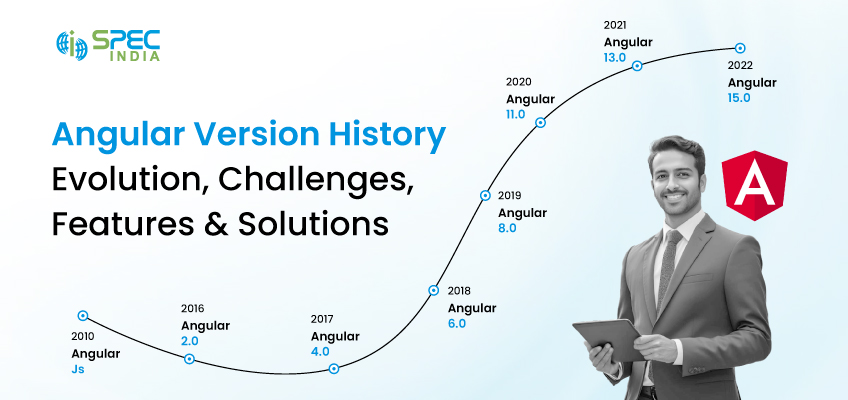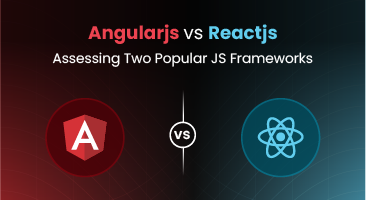Angular vs AngularJS – Comparing Popular Application Frameworks

Technology has never ceased to amaze and grow. As newer advancements are announced, changes are constantly experienced in the IT sector.
Web and mobile applications are now indispensable ingredients of any successful business, and the key to those is efficient application frameworks. Powered by Google, Angular, and AngularJS are prominent names when constructing user-friendly and robust applications.
Though they sound similar and originate from the same root, they have individual characteristics and benefits. Angular and AngularJS are popular frontend, open-source platforms that create dynamic SPAs. Since Google maintains both frameworks, they are reliable and have great community support from users, developers, and Google engineers.
A Brief History
AngularJS, or Angular 1, was Google’s first JavaScript framework developed in 2010. It was the first to attract developers to build interactive websites and single-page applications.
Owing to the competition, Google completely transformed from JavaScript to TypeScript, and then came the other versions of Angular. Subsequent versions were named Angular 2 and onwards. Angular Two was released in 2016, and one of the latest is Angular 11, released in November 2020.
Before we understand the difference between angular and angular, let us individually have a look at their features:
What Is Angular?
Angular is a TypeScript-based open-source web application framework led by the Angular Team at Google and by a community of individuals and corporations. – Wikipedia
Angular is a popular open-source TypeScript framework ideal for developing web applications. The latest versions of Angular are effective, fast, and smooth.
It has a modular design and an Angular CLI, considered apt for single-page applications with TypeScript and HTML. The Angular CLI feature empowers users to create project scaffolding. The fundamental block in Angular is NgModules, which offer a compiled structure for directives and components.
Angular Features:
- Easy development of native web applications
- Possesses command-line tools to help in addition to tests and components
- Utilizes contemporary web policy for offering competencies like speed in performance, zero-step installation
- Offers UI view with a great template syntax value
- Inbuilt API helps in developing complicated animation timeline
- Code modularity and optimization with OOPS
- Supports Dart, ES5, Angular CLI, the syntax for type checking, lambda operators
- Offers event of the most straightforward routing
- Two-way data binding
- Low code framework
- Effective design architecture
Which Companies Use Angular?
Lego, PayPal, Upwork, Gmail, Forbes, Microsoft Office, Deutsche Bank, Grasshopper, Delta, Mixer, Overleaf, Santander, Samsung, YouTube TV, Xbox, Udacity, DoubleClick, Freelancer, etc.
AngularJS Overview
AngularJS is a JavaScript-based open-source front-end web framework mainly maintained by Google and by a community of individuals and corporations to address many of the challenges encountered in developing single-page applications. – Wikipedia
AngularJS is a well-known open-source JavaScript-based application framework for dynamic web app development. It leverages HTML as the template language and changes static HTML into dynamic HTML.
It generates an environment that is easy to understand, fast to develop, and communicative. Its constantly evolving updates mainly aim to create single-page web applications. Its main features, like dynamic binding, help developers write less code.
AngularJS renders programs for MVVM (Model View View Model) and MVC (Model View Controller) architectures. It has proven its mettle by becoming one of the primary arms in the MEAN stack.
AngularJS Features
- JavaScript-based MVW (Model View Whatever) framework
- Supports data binding and easy event handling
- Form validations/animations
- Inbuilt services for template engine and routing
- JavaScript functions, controllers, and directives
- Faster application prototyping
- Document Object Model (DOM) manipulation
- Responsive and quick loading of web apps
- Utilization of plain HTML templates
- Easy and inbuilt testing
Companies Using AngularJS
YouTube, Amazon, Stack, Google, Udemy, Tokopedia, The Guardian, JetBlue, Lego, iStock Photo, Upwork, Netflix, Freelancer, Weather, Snapchat, Lyft, Delivery Hero, Tinder, etc.
Angular Vs. AngularJS – A Comparison Matrix
| Parameters |
Angular |
AngularJS |
| Language |
Written in TypeScript |
Written in JavaScript |
| Architecture |
Utilizes directives (structural, attributive) and components |
Operates with the MVC design structure |
| Mobile Friendliness |
Supports mobile-based applications |
Is not mobile-friendly |
| Dependency Injection |
Hierarchical dependency injection is utilized with declarations, providers, and constructor functions. |
Dependency injection is injected into different controller functions and directive definitions. |
| Managing Structure |
Angular has an easy structure to manage for large applications |
AngularJS has a rigid structure to manage if the code increases |
| Components |
TypeScript is a superset of ES6, uses the hierarchy of components, hence component-driven |
JavaScript uses terms of scope and controllers. Hence directive driven |
| Directives |
Standard directives |
Pack of directives |
| Performance and Speed |
The upgraded framework offers better speed and performance |
Two-way binding feature lessens time and efforts |
| Support for Tools |
Utilizes the Command Line Interface (CLI) to save on time |
It depends upon 3rd party tools like WebStorm and IDE |
| Expression Syntax |
Those properties that are included in () event binding and [] property binding are used for data binding |
ng-bind is used for data binding from model to view and back |
| Route Configuration |
Route configured with @RouteConfig{(…)} |
Route configured with $routeprovider.when() |
| Animation Package |
Separate packaging for animation in Angular |
The code required for animation is a part of the application |
Angular vs AngularJS – When To Use What?
Angular is best leveraged when large teams and developers use TypeScript. When building applications for the enterprise with certain complex features is required, Angular works better.
It also works best for progressive web apps and apps with dynamic content. It also performs well for applications where scalability is a significant criterion.
AngularJS is best utilized when the industry segment needs applications that pertain to the travel industry, mobile/eCommerce, video streaming, weather-based applications, etc.
It is ideal for developers looking at accessible frameworks that work quickly.
Difference Between Angular and Angularjs: The Conclusion
To each its own. Angular and AngularJS both stand for their identities and are being adopted by the user community with a lot of expectations and satisfaction.
If you are looking for a framework that is easy to learn and can make development faster, AngularJS is the choice. However, if you are looking at developing scalable, complex, enterprise-grade applications, Angular is the key.
Angular vs AngularJS, either way, is performance-driven, and the choice is entirely based on the requirements that organizations showcase.
SPEC INDIA is your trusted partner for AI-driven software solutions, with proven expertise in digital transformation and innovative technology services. We deliver secure, reliable, and high-quality IT solutions to clients worldwide. As an ISO/IEC 27001:2022 certified company, we follow the highest standards for data security and quality. Our team applies proven project management methods, flexible engagement models, and modern infrastructure to deliver outstanding results. With skilled professionals and years of experience, we turn ideas into impactful solutions that drive business growth.






